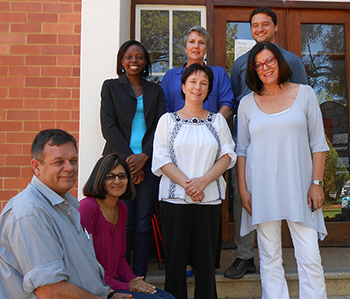Latest News Archive
Please select Category, Year, and then Month to display items
12 October 2020
|
Story Dr Cindé Greyling
|
Photo Supplied
 Exercise and nutrition can work wonders for your mental health – you don’t even have to ‘feel like’ or ‘enjoy’ moving around and eating well for it to work – it does its thing anyway.
Exercise and nutrition can work wonders for your mental health – you don’t even have to ‘feel like’ or ‘enjoy’ moving around and eating well for it to work – it does its thing anyway.
Nowadays, people talk about mental health like it is the common cold – which is good! But do you know what it really means? Being mentally healthy does not only refer to the absence of a mental illness but includes your emotional and social well-being. One would almost want to add physical well-being too, since a healthy body does indeed support a healthy mind. However, since so many people consider themselves ‘mental health experts’, some myths have been sold as truths.
Myth #1 – You are doomed.
Nope. Never. You are never doomed. There is always help. Mental-health therapies range from self-help, talk therapy, medication, to hospitalisation in some cases. Somewhere on this spectrum of treatments, there will be something that works for you. But you must be willing to get the help and do the work. For starters, exercise and nutrition can work wonders – you do not even have to ‘feel like’ or ‘enjoy’ moving around and eating well for it to work – it does its thing anyway.
Myth #2 – It won’t affect you.
It may. Research suggests that one in five people may suffer from a mental illness at some point in their lives. Being well now does not mean that it will stay that way. Biological and environmental factors both impact your mental health. Hopefully not, but at some point, you may experience an event that affects your mental health.
To remain integrated in a community is always beneficial
for anyone suffering from a mental or physical condition.
Myth #3 – Someone struggling with mental health must be left alone.
Hardly! To remain integrated in a community is always beneficial for anyone suffering from a mental or physical condition. You do not need to fix them, but to remain a friend. Continue to invite them, even if they decline. Do not judge, and do not try to understand. Just stay around.
Go and be kind to yourself, and to those around you.
Fighting the tuberculosis battle as a collective
2015-09-28

The team hard at work making South Africa a
healthier place |
Tuberculosis (TB) is second only to HIV/AIDS as the greatest killer worldwide due to a single infectious agent. More than 95% of TB deaths occur in low- and middle-income countries. Despite being more prevalent among men than women, TB remains one of the top five causes of death amongst women between the ages of 15 and 44 years. While everyone is at risk for contracting TB, those most at risk include children under the age of five and the elderly. In addition, research indicates that individuals with compromised immune systems, household contacts with pulmonary TB patients, and healthcare workers are also at increased risk for contracting TB.
According to the Deputy Director of the Centre for Health Systems Research and Development (CHSR&D) at the UFS, Dr Michelle Engelbrecht, research has found that healthcare workers may be three times more likely to be infected by TB than the general population.
The unsettling fact
“Research done in health facilities in South Africa has found that nurses do not often participate in basic prevention acts, such as opening windows and wearing respirators when attending to infectious TB patients,” she explained.
In response to this concern, CHSR&D, which operates within the Faculty of Humanities at the the University of the Free State (UFS) Bloemfontein Campus has developed a research project to investigate TB prevention and infection control in primary healthcare facilities and households in Mangaung Metropolitan.
Action to counter the statistics
A team of four researchers and eight field workers from CHSR&D are in the process of gathering baseline data from the 41 primary healthcare facilities in Mangaung. The baseline comprises a facility assessment conducted with the TB nurse, and observations at each of the facilities. Individual interviews are also conducted with community caregivers, as well as TB and general patients. Self-administered questionnaires on knowledge, attitudes, and practices about TB infection control are completed by all nurses and facility-based community caregivers.
Healthcare workers are the main focus of this research, given their increased risk of acquiring TB in healthcare settings. At clinics, interventions will be developed to improve infection control practices by both healthcare workers and patients. TB patients’ households are also visited to screen household contacts for TB. Those found to have symptoms suggesting TB infection are referred to the clinics for further assessment and treatment.
The findings of this study will serve to inform the development of an intervention to address TB prevention and infection control in primary healthcare facilities. Further funding will be sought to implement and evaluate the intervention.
Curbing future infections and subsequent deaths as a result of TB is the priority for the UFS. The cooperation and collaboration of the community, government, and sponsors will ensure that this project is a success, hence prolonging life expectancy.